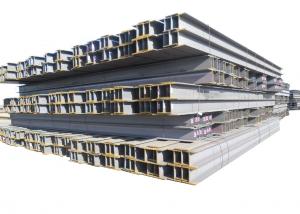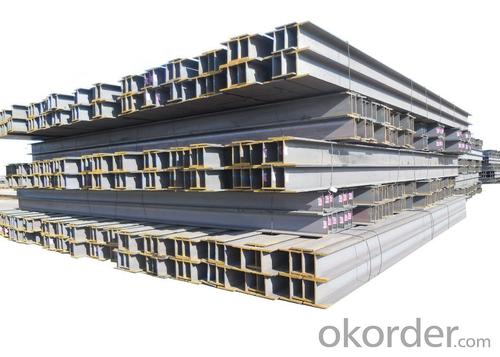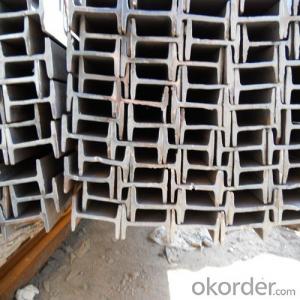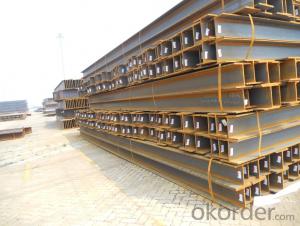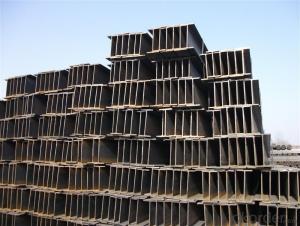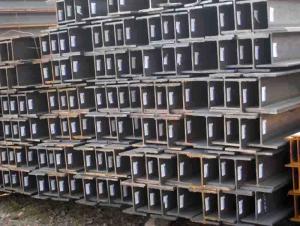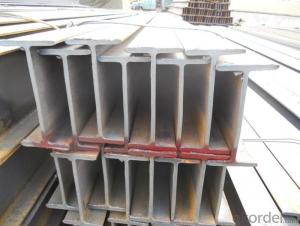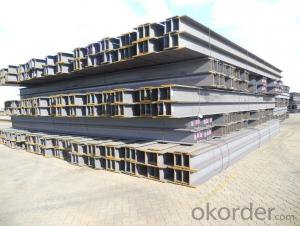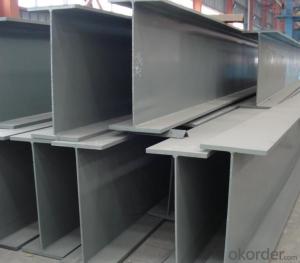Hot Rolled H-Beam Steel for Building Structures
- Loading Port:
- China Main Port
- Payment Terms:
- TT or LC
- Min Order Qty:
- 100MT m.t.
- Supply Capability:
- 10000MT m.t./month
OKorder Service Pledge
OKorder Financial Service
You Might Also Like
Specifications of Hot Rolled H-Beam Steel for Building Structures
1. Standard: JIS G3101, SS400(1987),GB700-88, Q235B,EN10034-1993 / EN10025-2004,
HEA100-HEA500,HEB100-HEB500
2. Grade: Q235, SS400 or Equivalent
3. Length: 6m,10m, 12m as following table
4. Invoicing on theoretical weight or actual weight as customer request
5.Payment: TT or L/C
6. Sizes:
SIZE(mm) | DIMENSION (kg/m) |
100*100 | 16.9 |
125*125 | 23.6 |
150*75 | 14 |
150*150 | 31.1 |
148*100 | 20.7 |
198*99 | 17.8 |
200*100 | 20.9 |
248*124 | 25.1 |
250*125 | 29 |
300*150 | 36.7 |
298*149 | 32 |
200*200 | 49.9 |
294*200 | 55.8 |
346*174 | 41.2 |
350*175 | 49.4 |
244*175 | 43.6 |
175*175 | 40.4 |
294*200 | 55.8 |
298*201 | 64.4 |
346*174 | 41.2 |
350*175 | 49.4 |
400*200 | 65.4 |
396*199 | 56.1 |
450*200 | 74.9 |
446*199 | 65.1 |
340*250 | 78.1 |
500*200 | 88.1 |
300*150 | 36.7 |
Usage & Applications of Hot Rolled H-Beam Steel for Building Structures
Commercial building structure ;Pre-engineered buildings; Machinery support structure; Prefabricated structure; Medium scale bridges; Ship-building structure. etc.
Packaging & Delivery of Hot Rolled H-Beam Steel for Building Structures
1. Packing: it is nude packed in bundles by steel wire rod
2. Bundle weight: not more than 3.5MT for bulk vessel; less than 3 MT for container load
3. Marks:
Color marking: There will be color marking on both end of the bundle for the cargo delivered by bulk vessel. That makes it easily to distinguish at the destination port.
Tag mark: there will be tag mark tied up on the bundles. The information usually including supplier logo and name, product name, made in China, shipping marks and other information request by the customer.
If loading by container the marking is not needed, but we will prepare it as customer request.
4. Transportation: the goods are delivered by truck from mill to loading port, the maximum quantity can be loaded is around 40MTs by each truck. If the order quantity cannot reach the full truck loaded, the transportation cost per ton will be little higher than full load.
5. Delivered by container or bulk vessel
Production flow of Hot Rolled H-Beam Steel for Building Structures
Material prepare (billet) —heat up—rough rolling—precision rolling—cooling—packing—storage and transportation
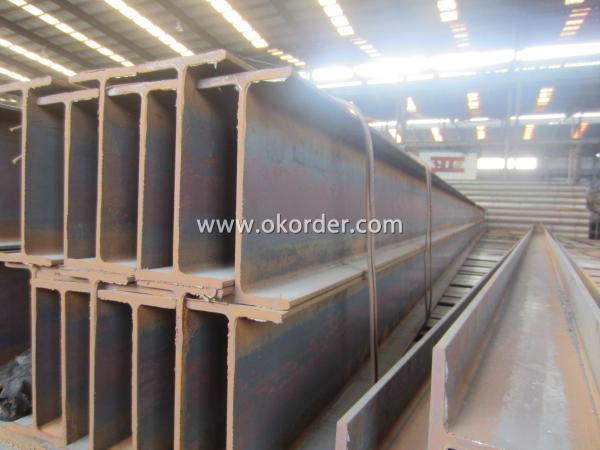
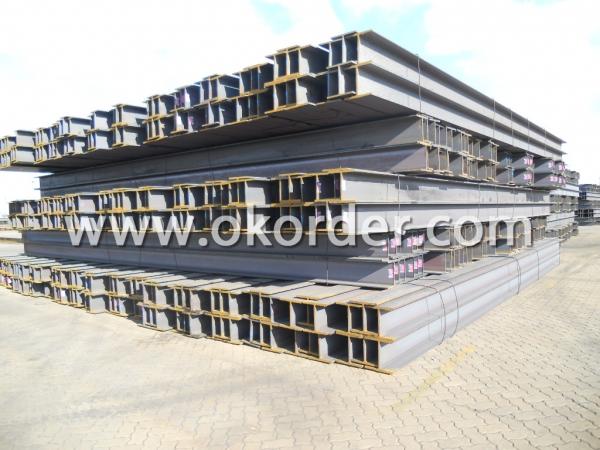
- Q: Can steel H-beams be used for exhibition halls or convention centers?
- Indeed, exhibition halls or convention centers can make use of steel H-beams. The reason for their prevalence in construction lies in their remarkable strength and durability. They serve to provide structural reinforcement and can endure substantial loads, rendering them appropriate for capacious and unobstructed spaces such as exhibition halls or convention centers. Furthermore, steel H-beams are easily fabricated and can be tailored to meet specific design prerequisites. They have the ability to construct expansive structures without the necessity of excessive columns or supports. On the whole, steel H-beams are a favored option when constructing exhibition halls or convention centers due to their ability to offer strength, adaptability, and cost-efficiency.
- Q: Can steel H-beams be used in the construction of airports?
- Yes, steel H-beams can be used in the construction of airports. Steel H-beams are commonly used in the construction industry for a variety of structural applications due to their strength and versatility. In airport construction, steel H-beams can be used for various purposes such as supporting the roof structure of terminal buildings, creating the framework for hangars, constructing bridges and walkways, and providing support for aircraft parking areas and runways. The use of steel H-beams in airport construction provides a durable and cost-effective solution, ensuring the structural integrity and safety of the airport infrastructure.
- Q: How do steel H-beams perform in high-rise buildings?
- Steel H-beams are commonly used in the construction of high-rise buildings due to their excellent performance under vertical loads and their ability to withstand high levels of tensile and compressive forces. These beams provide structural stability and support by distributing the building's weight evenly across their span, allowing for the construction of taller and more efficient structures. One of the key advantages of steel H-beams in high-rise buildings is their high strength-to-weight ratio. This means that they can support heavy loads while being relatively lightweight, making them ideal for constructing tall buildings where weight reduction is crucial. Additionally, steel H-beams have a high level of flexibility, allowing them to bend and deform under extreme loads without compromising the overall integrity of the structure. Furthermore, steel H-beams have excellent fire resistance properties, which is particularly important in high-rise buildings where fire safety is a paramount concern. Steel is inherently non-combustible and does not contribute to the spread of fire. Moreover, steel beams can be protected with fire-resistant coatings or encased in fire-resistant materials to enhance their fire resistance capabilities. In terms of construction efficiency, steel H-beams offer numerous benefits. They are prefabricated off-site, allowing for faster and more cost-effective installation. The uniformity and precision of the manufacturing process ensure consistent quality and dimensional accuracy. This leads to reduced construction time and labor costs, making steel H-beams a popular choice for high-rise buildings where time and cost savings are critical factors. Another advantage of using steel H-beams in high-rise buildings is their versatility. They can be easily customized and adapted to meet the specific design requirements of the structure. This flexibility allows architects and engineers to create innovative and aesthetically pleasing designs without compromising on structural integrity. Overall, steel H-beams are a reliable and efficient choice for high-rise buildings. Their high strength, fire resistance, construction efficiency, and versatility make them well-suited for withstanding the demanding conditions and loads experienced by tall structures.
- Q: Can steel H-beams be used in the construction of museums or cultural buildings?
- Yes, steel H-beams can definitely be used in the construction of museums or cultural buildings. Steel H-beams are commonly used in the construction industry due to their strength, durability, and versatility. They are designed to provide structural support, making them ideal for large-scale buildings like museums or cultural centers. The use of steel H-beams in construction offers several advantages. Firstly, their high strength-to-weight ratio allows for the creation of large open spaces without the need for excessive columns or supports, thus providing more flexibility in architectural design. This is especially important for museums or cultural buildings where open and spacious areas are often desired to display exhibits or host events. Furthermore, steel H-beams are capable of withstanding heavy loads and providing structural stability, making them suitable for supporting the weight of artistic installations, sculptures, or other heavy artifacts that might be found in museums or cultural buildings. In addition, steel H-beams can be easily fabricated to meet specific design requirements, allowing architects and engineers to create unique and aesthetically pleasing structures. This is especially important in cultural buildings where the architectural design often plays a significant role in the overall impact and experience for visitors. Lastly, steel H-beams have excellent fire-resistant properties, which is crucial for buildings that store and display valuable and irreplaceable artifacts. Steel is non-combustible and does not contribute to the spread of fire, ensuring the safety of both the building and its contents. Overall, steel H-beams are a reliable and cost-effective choice for the construction of museums or cultural buildings. They offer structural integrity, design versatility, and fire resistance, making them an excellent option for creating functional and visually appealing spaces to showcase art, history, or cultural heritage.
- Q: Can steel H-beams be used in wastewater treatment plants?
- Yes, steel H-beams can be used in wastewater treatment plants. Steel H-beams offer excellent strength and durability, making them suitable for various structural applications in wastewater treatment plants. They can be used for supporting heavy equipment and machinery, constructing platforms and walkways, and providing structural support for various treatment processes. Additionally, steel H-beams are resistant to corrosion, which is essential in an environment with high levels of moisture and chemicals. With proper coatings and maintenance, steel H-beams can provide long-lasting and reliable support in wastewater treatment plants.
- Q: Can steel H-beams be used for mezzanine floors?
- Indeed, mezzanine floors can utilize steel H-beams. Construction often relies on steel H-beams due to their robustness and capacity to bear heavy loads. Typically, mezzanine floors are incorporated into pre-existing structures to generate supplementary usable space, and steel H-beams furnish vital support for the floor. These beams possess the ability to endure substantial weights and distribute them evenly, rendering them appropriate for constructing mezzanine floors. Furthermore, steel H-beams offer durability and longevity, guaranteeing the stability and safety of the mezzanine floor.
- Q: What are the different types of steel H-beam connections used in bridge design?
- Bridge design commonly utilizes multiple types of steel H-beam connections to ensure stability and integrity. The following connection types are frequently employed: 1. Welded Connections: The most prevalent connection type involves melting and fusing H-beams together. Welded connections offer exceptional strength and rigidity, making them suitable for various bridge types. 2. Bolted Connections: High-strength bolts are used to connect H-beams, providing flexibility for disassembly and maintenance. However, bolted connections may not offer the same strength and rigidity as welded connections. 3. Riveted Connections: Previously common but now rare, riveted connections employ steel rivets to join H-beams. While providing good strength and durability, they can be time-consuming and expensive to install compared to other methods. 4. Moment Connections: These connections are utilized to transfer bending moments between H-beams. They offer high rigidity and are often used in bridge designs anticipating large loads or forces. 5. Shear Connections: Designed to transfer shear forces between H-beams, these connections are crucial for the bridge's stability and integrity, particularly in areas with significant horizontal forces. 6. Composite Connections: Composite connections combine steel H-beams with materials like concrete or timber. These connections provide the benefits of both materials, with steel offering strength and the additional material providing desirable properties like fire resistance or aesthetics. Ultimately, the choice of H-beam connection type depends on factors like bridge design, load requirements, and construction methods. Each type has its own advantages and limitations, and the selection should consider the specific needs and considerations of the bridge project.
- Q: Can steel H-beams be used in retail or shopping mall construction?
- Indeed, retail or shopping mall construction can incorporate steel H-beams. Due to their robustness and resilience, steel H-beams are widely employed in the construction industry. They offer indispensable structural reinforcement and are capable of withstanding substantial loads, rendering them an optimal choice for expansive commercial structures such as retail or shopping malls. Notably, steel H-beams present the advantage of effortless fabrication and installation, granting versatility in design and construction. The utilization of steel H-beams in the construction of retail or shopping malls guarantees a firm and secure framework, thus enabling the creation of commodious, open-plan retail spaces that can accommodate diverse architectural styles.
- Q: Can steel H-beams be used for supporting shipyard structures?
- Yes, steel H-beams can be used for supporting shipyard structures. Steel H-beams are commonly used in construction due to their high strength and load-bearing capacity. They are particularly suitable for supporting heavy structures, such as those found in shipyards. The H shape of the beams provides excellent structural stability and allows for efficient distribution of the load. Additionally, steel is a durable material that can withstand harsh marine environments, making it an ideal choice for shipyard structures.
- Q: How do Steel H-Beams contribute to the overall occupant productivity of a building?
- Steel H-beams play a crucial role in enhancing the overall occupant productivity of a building in several ways. Firstly, these structural steel beams provide excellent support and stability to the building, ensuring a safe and secure environment for the occupants. This structural integrity creates a sense of comfort and peace of mind, allowing individuals to focus on their work without worrying about the building's stability. Furthermore, steel H-beams have high load-bearing capacity, which enables the construction of larger and more open spaces. This open layout promotes collaboration and communication among occupants, fostering a more productive and efficient work environment. The absence of obstructive columns or walls allows for flexible space planning, making it easier to accommodate different work styles and adapt to changing needs. In addition, steel H-beams have a high strength-to-weight ratio, which means they can withstand heavy loads while being relatively lightweight. This characteristic allows for the construction of taller and more spacious buildings without compromising on safety. The availability of ample natural light and views from higher floors can greatly benefit occupants by improving their overall well-being and productivity. Moreover, steel H-beams are highly durable and resistant to various environmental factors such as fire, earthquakes, and severe weather conditions. This durability ensures the longevity of the building and reduces the need for frequent renovations or repairs, minimizing disruptions to occupants' work routines. Lastly, steel H-beams can be easily fabricated and installed, reducing construction time and costs. This efficiency in construction translates into shorter project timelines, enabling occupants to move into the building sooner and start their operations faster, thus maximizing their productivity. Overall, the utilization of steel H-beams in the construction of buildings greatly contributes to the overall occupant productivity by providing structural stability, creating open and collaborative spaces, optimizing natural light and views, ensuring durability, and enabling faster construction.
1. Manufacturer Overview
| Location | Tangshan, China |
| Year Established | 2009 |
| Annual Output Value | Above US$ 230 Million |
| Main Markets | Mid East; Southeast Asia; Korea |
| Company Certifications | ISO 9001:2008; |
2. Manufacturer Certificates
| a) Certification Name | |
| Range | |
| Reference | |
| Validity Period |
3. Manufacturer Capability
| a) Trade Capacity | |
| Nearest Port | Tianjin; |
| Export Percentage | 81% - 90% |
| No.of Employees in Trade Department | 21-50 People |
| Language Spoken: | English; Chinese; |
| b) Factory Information | |
| Factory Size: | Above 500,000 square meters |
| No. of Production Lines | 1 |
| Contract Manufacturing | OEM Service Offered; |
| Product Price Range | Average |
Send your message to us
Hot Rolled H-Beam Steel for Building Structures
- Loading Port:
- China Main Port
- Payment Terms:
- TT or LC
- Min Order Qty:
- 100MT m.t.
- Supply Capability:
- 10000MT m.t./month
OKorder Service Pledge
OKorder Financial Service
Similar products
Hot products
Hot Searches
Related keywords
